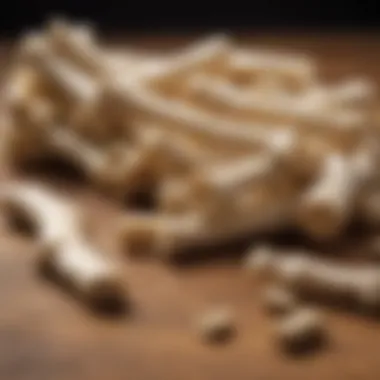The Impact of Hard Chew Bones on Dog Nutrition & Dental Health


Intro
Hard chew bones have a significant role in the diet and health of dogs. Many pet owners often underestimate their influence, thinking of them merely as snacks or playthings. This article seeks to connect the dots between hard chew bones, canine nutrition, and dental well-being. Understanding these relationships is vital for promoting overall health in dogs. In this guide, you will learn about the different types of chew bones, tips on selecting the right one for your pet, and how they contribute to dental hygiene. This examination of hard chew bones will help in making informed choices that align with the needs of your dog.
Fascinating Facts About the Animal
Unique Characteristics
Dogs, as a species, exhibit remarkable diversity in size, form, and temperament. From tiny Chihuahuas to massive Great Danes, dogs show each breed's unique characteristics that influence their chewing habits. Furthermore, their dental structure supports varying chewing patterns. The ability to chew is not just for enjoyment; it's crucial for their nutrition. As natural scavengers, dogs have a strong urge to chew, which is an instinct tied to their survival and foraging behaviors.
Extraordinary Abilities
Dogs possess an acute sense of smell, which aids them in identifying food. This unique capability does not only enhance their hunting and foraging but also determines their preference for flavors and textures, including chew bones. Chewing provides not only nutrition but also stimulates their minds. Engaging with hard chew bones helps prevent boredom, which can often lead to destructive behavior in dogs. Thus, these bones serve multifaceted roles in a dog's life.
Behavior and Habitat
Natural Habitats
In the wild, dogs' ancestors relied on chewing to consume raw meat and bones, providing essential nutrients. This evolutionary background gives us insights into their need for hard chew items today. Accessing natural habitats like forests and fields allows other canines to chew bones from hunted prey. Domestic dogs, though sheltered, retain this instinct, making hard chew bones an important dietary component.
Social Structures
The dynamics of social structures in canines are intriguing. Dogs often chew together, particularly in packs. This communal chewing can strengthen bonds among them. Such behavior indicates the social nature of dogs and how their chewing habits can impact emotional well-being.
Recent Scientific Discoveries
Latest Research Findings
Recent studies reveal connections between hard chew bones and oral health in dogs. Regular chewing can contribute to plaque reduction and prevention of gum disease, which is a significant health concern. Research shows that specific materials in chew bones may even reduce the frequency of dental infections. Understanding these findings helps dog owners make informed decisions about which bones to offer.
Breakthroughs in Animal Biology
Advancements in veterinary science have studied how dogs' teeth and jaws react to chewing hard materials. Biologists explore how certain bone types interact with dental structures, underscoring the importance of selecting appropriate chew materials based on a dog's size and chewing strength.
Cultural Significance
Animals in Folklore
Dogs have a long-standing presence in human culture, often symbolizing loyalty and protection. This bond is encapsulated in many stories and myths that highlight the importance of dogs in human life, influencing how people view their roles, including that of support animals and companions that require proper nutrition and care.
Influence on Art and Literature
Art and literature from various cultures often depict dogs in contexts that emphasize their loyalty, companionship, and sometimes their dietary habits. These representations underline society's understanding of dogs as integral parts of family and community, bringing to light the necessity for proper care, including appropriate nutrition through options like hard chew bones.
Understanding the significance of hard chew bones for dogs can profoundly impact their well-being and overall health. Making informed choices is crucial for every dog owner.
Prologue to Hard Chew Bones
Hard chew bones play a crucial role in canine nutrition and dental health. Their significance goes beyond being a mere treat; they offer benefits that can enhance a dog's overall well-being. Understanding the function of these bones is essential for dog owners who seek to integrate them into their pets' diets. The right selection of hard chew bones can foster healthier chewing habits, assist in dental hygiene, and provide essential nutrients needed for optimal canine health.
Understanding Chewing Behavior in Dogs
Chewing is a natural behavior for dogs. It provides mental stimulation and can alleviate boredom. Dogs often chew to explore their environment, relieve teething pain, and reduce anxiety. This instinctive action can also lead to numerous benefits when directed toward appropriate objects, such as hard chew bones.
Studies suggest that chewing can decrease stress levels in dogs. Additionally, the act of chewing strengthens the jaw muscles and stimulates saliva production. Saliva helps to neutralize acids produced by bacteria in the mouth, which reduces the risk of dental issues. Understanding this behavior is vital in selecting the right types of chew bones that will cater to a dog’s instinctual needs.
Definition and Purpose of Hard Chew Bones
Hard chew bones are defined as durable edibles designed for dogs to chew on. They can be made from various materials, including raw bones, commercial formulations, and synthetic products. The primary purpose of these bones is to provide dogs with a way to satisfy their natural chewing instincts while concurrently promoting dental health and nutritional benefits.


The right hard chew bone can serve multiple functions. It can be a source of essential nutrients, aiding in bone health and supporting overall wellness. Additionally, chewing on hard bones can help reduce plaque buildup, which can lead to periodontal disease if left untreated. Thus, incorporating hard chew bones into a dog's diet provides not only enjoyment but also contributes positively to their physical health.
Nutritional Benefits of Hard Chew Bones
The discussion surrounding the nutritional benefits of hard chew bones is essential for canine health. These options can offer more than just entertainment; they can be pivotal in ensuring a balanced diet and promoting overall wellness. Understanding these benefits can help dog owners make informed decisions regarding their pets' dietary choices.
Source of Essential Nutrients
Hard chew bones can serve as a valuable source of essential nutrients for dogs. These nutrients can impact various aspects of health, including skin, coat, and joint health.
Nutritional Content
- Protein: Many hard bones provide a substantial amount of protein. Just like us, dogs require protein for muscle development and repair.
- Calcium and Phosphorus: Hard bones, particularly raw ones, are rich in calcium and phosphorus, which are crucial for bone development and maintenance. These minerals can support strong bones and teeth, reducing the risk of fractures and dental issues.
- Vitamins: Some chew bones are fortified with vitamins that can enhance a dog's immune system. This can also lead to healthier skin and coat conditions.
Safety and Considerations: It is critical to choose appropriate bones. These should be selected based on a dog's size and chewing habits. Smaller dogs may need smaller bones to avoid choking, while larger breeds might require more substantial options.
Caloric Considerations
The caloric content of hard chew bones is another factor that should be considered when incorporating them into a dog’s diet. While these bones can provide important nutrients, they also contribute to the overall caloric intake.
Identifying Caloric Content
- Bone Types: Different types of bones have distinct caloric values. For instance, raw bones typically contain fewer calories than their commercial counterparts, which may have added ingredients or flavorings.
- Serving Size: The amount of bone given should be tailored to the individual dog's needs. Overindulgence can lead to obesity, making weight management a vital aspect of utilizing chew bones in a dog's diet.
- Balanced Diet: Hard chew bones should not replace a balanced daily meal. They should complement a well-rounded diet instead.
To maximize benefits while minimizing risks, always calculate the total caloric intake when adding chew bones to the diet plan.
Careful attention to the caloric implications not only helps in maintaining a healthy weight but also supports the overall nutritional strategy for your dog. Understanding these nuances can empower dog owners to make the right choices. By effectively integrating hard chew bones, pet owners can contribute positively to their dog's dietary health.
Dental Health Implications
Dental health in dogs is a critical aspect of their overall well-being. Poor dental hygiene can lead to a host of problems, including bad breath, tooth loss, and serious infections. Hard chew bones play a significant role in maintaining good oral hygiene for dogs. This section delves into the mechanics of how chewing effectively removes plaque and the preventative measures against periodontal disease.
Mechanics of Chewing and Plaque Removal
Chewing is a natural behavior for dogs. When they gnaw on hard chew bones, the physical action helps to dislodge food particles and plaque that accumulate on their teeth. The abrasiveness of the bone scrapes against the enamel, providing a cleaning effect that toothbrushes cannot replicate.
The mechanical action of chewing stimulates saliva production, which is vital for oral health. Saliva contains enzymes that aid in breaking down food particles and neutralizing harmful bacteria in the mouth. Increased saliva flow can help decrease the overall bacterial count, which in turn can reduce the risk of dental diseases. Regular chewing can serve as an effective method to maintain cleaner teeth and fresher breath. While hard chew bones should not replace routine dental care, they can complement oral hygiene practices by offering additional protection against plaque buildup.
Regular chewing can help reduce the risk of dental diseases by lowering bacterial counts in the mouth.
Preventing Periodontal Disease
Periodontal disease is one of the most common health issues affecting dogs, caused primarily by the buildup of plaque and tartar. This condition begins as gingivitis and, if left untreated, can progress to periodontal disease, resulting in inflammation of the gums and eventual tooth loss. Incorporating hard chew bones into a dog’s diet can be a proactive approach to help prevent the onset of these dental issues.
Chewing on hard bones not only cleans the teeth but also massages the gums. Healthy gums are essential for preventing infections that can lead to periodontal disease. Moreover, regular chewing helps to maintain proper oral structure by strengthening the supporting tissues around the teeth.
It is important for dog owners to choose appropriate chew bones, as not all hard bones provide the same benefits. Some bones can be too hard and may cause tooth fractures or other dental issues. Consulting with a veterinarian can help guide owners to make better decisions regarding the best options for their pets' dental health.
In essence, by integrating hard chew bones into a dog's routine, owners can aid in maintaining their canine companion’s dental health and help avoid costly dental procedures down the line.
Types of Hard Chew Bones
Hard chew bones serve a vital purpose in canine nutrition and dental health. Understanding the different types can help pet owners make informed choices about what to offer their dogs. Each category presents distinct benefits and considerations.
Raw Bones
Raw bones, often sourced from animals such as beef or chicken, are a natural choice for many dog owners. These bones can provide not just a good source of protein, but also essential nutrients for overall health. The act of chewing raw bones helps to promote jaw strength and can contribute to maintaining healthy teeth. However, there are important precautions to take.
When selecting raw bones, consider the size. Large bones can be beneficial for big breeds, while smaller breeds should be given more appropriately sized options. It's also crucial to supervise your dog while they chew. Raw bones can splinter or fragment, posing potential choking hazards. In addition, watch for any signs of digestive upset, which may arise from a sudden change in diet.
Commercial Chews


Commercial chews are widely available and designed specifically for canine dental health. These products often contain added flavor and nutrients that can appeal to dogs and their owners. Commercial chews can provide a reliable and convenient option, especially for those concerned about the safety and hygiene of raw bones.
Before selecting a commercial chew, it is essential to look for quality ingredients and certifications. The best products will be made from natural components without fillers. Keep an eye on any additional ingredients that could cause allergies or digestive problems in your dog.
Regular use of commercial chews can contribute positively to dental hygiene, reducing plaque buildup effectively. However, be mindful of the caloric content, as excessive consumption can lead to weight gain.
Synthetic Options
Synthetic chew bones are an alternative to both raw and commercial options. These products are often made from rubber or nylon and are designed to withstand rigorous chewing. Many synthetic options provide an extended lifespan, allowing for longer chewing sessions without wear. They can also be non-toxic and free of harmful additives.
On the downside, some dogs may not find synthetic chews as appealing in terms of taste, which may lead to uninterested pets. Always observe your dog to ensure they are not trying to swallow large pieces, which can lead to digestive issues. It is also essential to choose the right hardness; too hard and they can fracture teeth, too soft and they may not offer any dental benefits.
Dogs’ chewing preferences can vary significantly. Keeping a variety may help identify which types your pet enjoys most.
By understanding these categories—raw bones, commercial chews, and synthetic options—owners can better tailor their dog's chewing habits to their nutritional needs and dental health. Each type presents its own set of advantages and challenges, making informed selection crucial.
Choosing the Right Bone for Your Dog
Choosing an appropriate hard chew bone for your dog is crucial. It impacts their nutrition and plays a significant role in oral health. When selecting the right bone, several factors need to be considered to ensure it meets your dog's needs. Choosing the wrong type can lead to injuries or nutritional imbalances.
Factors to Consider
Dog Size
Dog size is a critical factor when selecting a chew bone. Larger dogs have stronger jaws and require more robust bones.
- Key characteristic: Stronger chewing ability in larger breeds.
- This makes larger bones like beef knuckles or shank bones a popular choice for them.
- However, smaller dogs might find these bones too challenging and could risk choking. Thus, a smaller breed would benefit from softer or smaller-sized bones designed specifically for their size, such as chicken necks or lamb shanks.
Chewing Strength
Chewing strength defines how vigorously a dog can chew. Different breeds have varying chewing habits.
- Key characteristic: Strong chewers may require denser bones.
- Chewing strength affects bone selection since a dog that chews forcefully might fracture weaker bones. A dog with moderate chewing strength may manage softer options well. Evaluating your dog’s chewing habits can prevent potential issues related to chew bone durability.
Allergies and Dietary Restrictions
Allergies and dietary restrictions are essential considerations when choosing chew bones.
- Key characteristic: Dogs might have specific ingredient sensitivities.
- Some dogs could be allergic to certain proteins in commercial chew bones, leading to gastrointestinal discomfort or skin reactions. Selecting bones made from hypoallergenic sources can ensure that your dog enjoys their chewing experience without adverse health effects.
Understanding these factors is critical when choosing the right chew bone. It can help optimize both their nutrition and dental health.
Consulting with Veterinarians
When in doubt, consulting with a veterinarian can provide tailored recommendations. They can offer insights based on your dog’s health background, lifestyle, and specific needs. Professional guidance ensures that the selected chew bone aligns with your dog's overall health objectives.
Risks and Precautions
Understanding the risks and precautions associated with hard chew bones is essential for dog owners. While these bones offer a variety of benefits, they can also pose certain dangers. Being aware of these issues helps in making informed decisions about your dog's chewing habits. It's vital to consider the specific elements that affect safety, such as the type of bone, size of the dog, and supervision during chewing.
Potential Injuries from Chewing
Choking Hazards
Choking hazards are a serious concern when it comes to hard chew bones. Small pieces of bones can break off and pose a risk if they lodge in a dog's throat. A key characteristic of choking hazards is the size and texture of the chew. While some bones are designed to be consumed, others can splinter, increasing the risk of choking. This aspect is pertinent because it emphasizes the need for appropriate sizing when selecting chewing bones.
Advantages of being aware of choking hazards:
- Increases safety by allowing owners to choose the right bones.
- Helps in monitoring feeding habits to prevent accidents.


Tooth Fractures
Tooth fractures can occur when dogs chew on excessively hard bones. The unique feature of tooth fractures is the damage they cause to dental health, often requiring veterinary intervention. Understanding this risk is important as it highlights the need for moderation in chewing. Excessively hard options may cause more harm than benefit.
Implications of tooth fractures include:
- Potential pain for the dog.
- Costly veterinary bills for repairs.
Digestive Concerns
Obstruction Risks
Obstruction risks refer to the potential for bones to cause blockages in a dog's digestive tract. This concern is critical as it can lead to severe health issues, including vomiting and abdominal pain. The important characteristic of obstruction risks is their unpredictable nature; even seemingly safe bones may pose this risk depending on the dog's chewing habits.
Prevention strategies include:
- Choosing the right size and type of bone.
- Monitoring your dog while they chew.
Pancreatitis and Other Conditions
Pancreatitis and other gastrointestinal conditions can arise from feeding dogs inappropriate chew bones. The key characteristic here is the fat content associated with some bones, which can trigger inflammation of the pancreas. Being aware of this risk is vital for owners concerned about their dog's overall health.
Considerations include:
- Selecting low-fat options for dogs prone to digestive issues.
- Consulting with veterinarians to ensure safe feeding practices.
Being informed about the potential risks associated with hard chew bones empowers dog owners to make better choices for their pets. Awareness can significantly reduce health complications related to chewing.
Safe Chewing Practices
Safe chewing practices are essential for ensuring that dogs can enjoy hard chew bones without risk of injury or health issues. It is critical for pet owners to understand the best ways to introduce these bones into their dog's routine. By doing so, one enhances the benefits while minimizing potential risks. This section will explore two key aspects: the importance of supervision while chewing, and the concept of rotating chew bones.
Supervision while Chewing
Supervision is paramount when dogs are engaged in chewing activities. It's easy to underestimate the risks associated with bones, but many health issues can arise if dogs are left unsupervised. When a dog chews alone, it may not only swallow pieces that are too large but also exhibit aggressive chewing behavior that can lead to choking or tooth fractures.
Pet owners should keep an eye on their pets during chew times. Observing how a dog interacts with a chew bone helps ensure that they do not consume it too quickly or aggressively. Signs of distress, such as gagging or changes in chewing technique, should be addressed promptly. Furthermore, supervision allows you to intervene if the dog shows signs of losing interest in the bone, as frequent supervision encourages safer chewing habits and can lead to more controlled chewing practices.
Rotation of Chew Bones
Another key practice is the rotation of chew bones. Dogs, like humans, can experience boredom. This boredom can lead to destructive behavior or, significantly, less interest in the chew bones presented to them. By introducing a variety of bones into their diet, you can maintain their interest.
Rotating chew bones also helps prevent overconsumption and keeps dental care in check. Each type of chew bone serves a different nutritional purpose. For instance, raw bones provide calcium and phosphorus, while commercial varieties may have added vitamins. By varying the types, owners ensure a more balanced intake of nutrients.
Here are some tips for effective bone rotation:
- Introduce Different Textures: Vary between soft and hard options to keep dogs engaged.
- Select Based on Nutritional Needs: Consider your dog's age and any special dietary needs before selecting.
- Change Regularly: Every week, swap out the current bone for a different type to maintain interest and nutritional balance.
Effective chewing practices lead to better health outcomes for dogs. By supervising and rotating chew bones, pet owners contribute positively to their dog's nutrition and dental hygiene.
Closure and Future Considerations
Summary of Key Points
In this article, several key points have emerged:
- Nutritional Benefits: Hard chew bones provide essential nutrients that can support a dog's overall health.
- Dental Health: Chewing on hard bones assists in plaque removal and helps prevent periodontal disease.
- Types of Bones: Options range from raw bones to commercially available chews, each with distinct characteristics.
- Proper Selection: Factors such as a dog's size and chewing habits are critical when selecting an appropriate chew bone.
- Safe Practices: Supervision and proper rotation of chew items are essential to prevent injuries and gastrointestinal issues.
Emerging Trends in Canine Nutrition
As the field of canine nutrition evolves, several emerging trends have gained attention. These include:
- Natural Ingredients: There is a growing preference for chew bones made from natural ingredients, free of artificial additives. Many dog owners seek transparency about the sources and production methods of these products.
- Customized Nutrition: Tailoring chew selections based on individual dogs' needs is becoming more common. This includes considering age, health conditions, and even allergies.
- Functional Chews: A rise in products designed specifically for oral health, such as dental chews fortified with enzymes or probiotics, indicates a shift toward functional attributes.
By acknowledging these trends, dog owners can make decisions that reflect current knowledge and practices. A well-thought-out approach to hard chew bones contributes significantly to enhancing a dog’s quality of life.
Understanding and implementing these considerations ensures that pets receive not only enjoyment from chewing but also an avenue for improved health.







